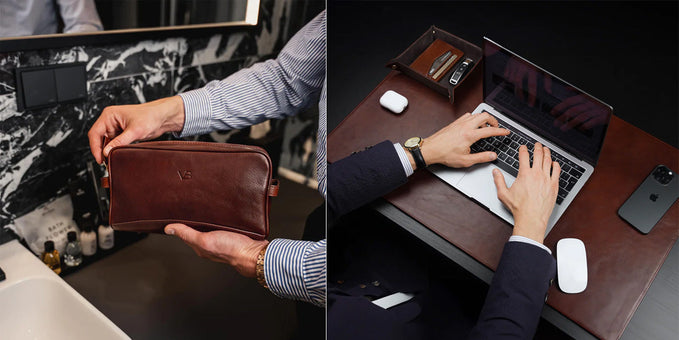What Is Leather Tanning?

To turn animal hides into a material suitable for clothing, furniture and other similar uses; the hides go through a chemical process called tanning. This process changes the skin's molecular structure to increase its durability and prevent the hides from decomposing. The process can also entail coloring the hides or altering their feel by hardening or softening them.
To prepare the hides for the process of tanning, the hair, grease, fat and salt is removed, and then the hide is soaked in water. This time varies according to the starting hide and the desired finished product, but ranges from as little as six hours to a couple of days. The process can produce a lot of strong odors, especially if done in the traditional manner and without treating the off gases in some way, so historically the trade has been relegated to the outskirts of town, usually near an ample water source. It was sometimes officially labeled a noxious or “odiferous trade.”
Tanning takes its name from the use of tannin in traditional methods. Tannin was extracted from the bark of certain trees. A more modern method, called chrome tanning, was developed in the 1800s and employs chromium salts instead of natural tannins to produce a similar effect.
Traditionally, tanning used tannin, an acidic chemical compound from which the tanning process draws its name, derived from the bark of specific trees. An alternative method, developed in the 1800's, is chrome tanning, where chromium salts are used instead of natural tannins.
History of Tanning
The English word “tanning” comes from the Latin term tannāre, a derivative of tannum, meaning “oak bark.” From ancient times, people have used leather for the construction of waterskins, bags, clothing and even homes. Certain treatments made leather useful for armor, quivers, scabbards and various types of footwear. Of course, using hides for these purposes requires tanning. We have evidence of tanning taking place in Mehrgarh (current-day Pakistan) as far back as 7000 BCE, stretching through to 3300 BCE. Sumerians were using tanned leather by 2500 BCE on their chariot wheels, attached by copper studs.
Tanning was known for its strong odors, so it was often designated an “odiferous trade” and allowed only on the outskirts of towns and cities, usually in neighborhoods where the poor lived and where other such trades were located. Even today, when old methods of tanning are used, tanneries are isolated from areas where people are likely to frequent.
When skins first arrive at the tannery, they are raw. They are stiff, still have hair, fat and other body fluids dried onto them, and are often dirty. In ancient times, tanners would soak the hides in water first, softening them up for further treatments. Once the hides were softer, the tanners would pound them and scrape off any residual fat and tissue that might make the hide stiffen up again once dried. In order to remove hair from the hides, they were soaked in a solution of urine, painting it with an alkaline lime combination, or dipping it in a salt solution after allowing several months of letting it putrefy. Each of these processes loosens the hair, allowing it to be scraped off afterwards. A great deal of the odor of the tanneries was produced from this part of the process.
Once the hair was gone, “bating” took place to further soften the hide. This entailed hammering dog or pigeon dung into the skin or soaking it in a solution of animal brains. The bacteria in the dung produced enzymes, which in turn produced fermentation in the hide. This also produced a lot of odor.
After this point, vegetable tanning actually began. Cedar oil, tannin, or alum would be rubbed into the hides to serve as a tanning agent. Stretching the skin then helps to draw in the tanning agent, while allow moisture to escape.
After the 1840 adoption of using chromium (III) to soak gut sutures for surgery and wound repair, some tanners applied the technology to leather treatment, creating an alternative to vegetable tanning.
Related leather articles:
- Leather
- Faux leather
- Vegan leather
- Bonded vs faux vs real leather
- Bonded leather
- Genuine leather
- Pleather
- Top grain leather
- What is full grain leather
- Italian leather
- How to tell if leather is real
- Buffalo leather
- Suede vs Leather
- What is Real Leather
- Pu Leather vs Faux Leather
- Alternative Leather
- Chrome Tan Leather
Modern Leather Bags
In modern times, the most popular use of leather is for consumer fashion, more specifically bags. Leather bags are popular amongst both men and women, including briefcases, travel bags, laptop bags, purses, shoulder bags, and messenger bags.
Preparation of Leather
An animal skins begins, obviously, on an animal. Each animal is skinned immediately after being killed, because the body heat must still be in the tissues. For this reason, it is most often done in a slaughterhouse, though it is sometimes done on a farm or by a fur trader for certain types of skin.
From this point, skins are cured in salt to prevent putrefaction due to bacterial growth in the collagen. Osmotic pressure increases until the skins are no longer hospitable to bacteria. The curing process removes moisture from the hides and prevents them from spoiling between the time of their removal and the tanning process. In one version of this, called wet-salting, the hides are heavily salted and then spend a month packed tightly together. In another version, called brine-curing, the hides are placed into a saltwater bath and agitated for 15-17 hours. Placing hides in very low temperatures can also result in curing.
What are Beamhouse operations?
The term “beamhouse operations” refers to all of the steps that occur between the curing of the hides and the actual tanning. These steps include soaking, liming, removal of tissues such as hair and fat, deliming, bating (or puering), drenching and pickling.
Soaking Hides
The hides are first soaked in clean water to remove the salt added during the curing process. Moisture is increased to prepare the hides for further processing. At this stage, biocides such as dithiocarbamates are sometimes used. To protect against mold development due to moisture in the hides, fungicides are sometimes added later in the process. In the past, chemicals such as pentachlorophenol and mercury-based biocides were used for this, but their use was deemed dangerous and banned in 1980. A typical example of a fungicide used for this purpose today, is 2-thiocyanomethylthiobenzothiazole.
Liming Hides
The soaked hides are then treated with a basic agent called milk of lime. Sharpening agents, such as sodium sulfide, cyanides, amines, and others are usually added as well, to reduce disulfides. This has the effect of removing hair and keratinous matter, removing interfibrillar soluble proteins (i.e. mucins), swelling up and splitting fibers, reducing natural grease fats, and preparing the collagen for tanning.
The resultant breakdown of the disulfide link of the amino acid cystine weakens the hair. The sharpening agent provides hydrogen atoms that weaken the keratin by weakening the cystine molecular link, rupturing the covalent disulfide bond links. This results in a breakdown of the hair proteins as well, and so causes some additional dehairing as well.
Liming also produces a shift in the isoelectric point of the collagen, a tissue-strengthening protein unrelated to keratin, to around pH 4.7.
If any hair is left on the hide after this process, they are removed through scraping the skin with a dull blade. This process is called “scudding.”
Related post: How to Reform a Leather Bag
What are Deliming and Bating?
Deliming is a process that reduces the pH of the collagen so that enzymes may act upon it. An additional process, called bating, uses other enzymes to soften the hides further. This is only done if the leather is to be used in such a way that additional softness is desired. It could be left somewhat harder for uses requiring stiffer, more durable leathers. In early tanning processes, bacterial fermentation such as dung-water soaking was required, but today tanners can use enzymes that are purified agents, for the same use.
Related articles:
- Leather guide for beginners
- What is leather patina
- Vegetable tanned leather
- What is artificial leather?
- Where does leather come from
- Mushroom leather
- Napa leather
- Pebbled leather
- Leather grades
- How is leather made
- Suede
- PU leather
- Bonded leather vs Faux leather
Why do you Pickle Hides for Leather?
Once the bating has been accomplished, the hides are treated with sodium chloride (common table salt) and sulfuric acid in the case of mineral tanning. This lowers the pH of the collagen to 2.8-3.0, which in turn allows the tanning agent to be absorbed more deeply into the hide’s substrate. This process is called pickling. The salt penetrates first in order to reduce swelling as the pH drops.
Related post: How to Repair Cracked Leather
The Tanning Process
Chrome tanning
Since its initial use in the tanning industry, in the late 1800s, Chromium (III) sulfate ([Cr(H2O)6]2(SO4)3 has been considered the most efficient and effective tanning agent. These compounds dissolve into the hexaaquachromium (III) cation, [Cr(H2O)6]3+. The hexaaquachromium (III) cation undergoes olation at higher pH levels, yielding polychromium (III) compounds through crosslinking of the collagen subunits. The presence of various ligands in the [Cr(H2O)6]3+ tanning bath (as opposed to water), such as the sulfate anion, collagen carboxyl groups, amine groups from the side chains of the amino acids, and masking agents, creates a more complex chemistry. These masking agents suppress polychromium (III) chain formation. Examples include carboxylic acids, such as acetic acid. Due to the presence of these masking agents, tanners can increase collagen reactivity by increasing the pH, without risking inhibition of chromium (III) complex penetration.
Collagen has a high glycine, proline and hydroxyproline content, which creates a helical structure in collagen. This strong presence of hydroxyproline enables significant cross-linking within the helical structure through hydrogen bonding. Hydroxide helps to form ionized carboxyl groups (RCO2−) during the liming process, before the tanning agents (chromium salts) are introduced. Once pickling occurs, chromium ions are easily transported because the collagen carboxyl groups are temporarily pronated. Carboxyl groups are then ionized and coordinate as ligands to the chromium (III) centers of the oxo-hydroxide clusters, during a step called basification. The spaces between protein chains in collagen increase from 10 to 17 Å, which is consistent with polychromium species cross-linking such as occurs during olation and oxolation.
Before basic chromium species are introduced, the hides must be prepared by undergoing several preparatory steps. The pH must be acidic enough to allow passage of the chromium complexes between the fibers and residues of the collagen. The pH can then be raised once the desired level of penetration has been achieved, in a step called basification. Raw, chrome-tanned skins are referred to as “wet-blue,” due to their gray-blue hue at this stage of the process. They are stretchable, which makes them excellent for handbag and garment manufacture, and the process is much quicker than that used in vegetable tanning, which results in lower production costs.
Related guide: Leather Backpacks Fashion Guide
After the chromium agent is added to the bath, it is treated with sodium bicarbonate. This basification process results in an increase of pH from 3.8 to 4.0, and a temperature increase to 40 °C. This shift causes cross-linking between the collagen and the chromium. This strong bond is the reason that chromium is such a good tanning agent. Chromium-tanned leather also only contains about 4 or 5% chromium, and so is considered very efficient. This efficiency results in increased hydrothermal stability and resistance to shrinking when exposed to heated water.
Vegetable tanning
Vegetable tanning is characterized by the use of naturally occurring tannins obtained through the processing of certain tree barks. Tannins are a class of polyphenol astringent chemicals that occur naturally in some bark and leaves. These compounds bind to collagen proteins in the hide and reduce water solubility and are more resistance to bacteria. During this process, the flexibility of the hide also increases.
Featured product: Voyager Leather Carry-On Bag with Wheels (link)
Modern vegetable tanning tends to use certain types of bark, including oak, chestnut, redoul, tanoak, hemlock, wattle (acacia; see catechol), mangrove, quebracho, and myrobalans from Terminalia spp.
Ethiopian tanners have used vegetable oils of the Niger seed (Guizotia abyssinica) combined with flaxseeds to treat the flesh side of the hides. Yemeni and Egyptian tanners cured hides using a bath of crushed bark and leaves from the Salam acacia (Acacia etbaica; A. nilotica kraussiana).
In general, vegetable-tanned hides are quite stiff and durable, and are commonly used for luggage, furniture, footwear, belts, and other clothing accessories.
All of the bags manufactured by Von Baer use this vegetable tanning method.
Alternative chemicals
There are alternative chemicals that are sometimes used in the tanning of leather. Leathers tanned in this way are known as Wet White leather, as the resulting product is off-white in its undyed, semi-finished form. Common chemicals used to produce wet white include, sometimes in combination: aldehydes, aluminum, zirconium, titanium, or iron salts.
One of the primary attractions of producing wet white leather is the concern over the environmental impact of chromium (VI), a byproduct of chromium tanning techniques. Wet white production techniques do not use chromium compounds, and so do not produce those byproducts. It is therefore considered more environmentally friendly than chromium tanning in general.
Further reading: Types of Bags for Men
Natural tanning
There are some natural conditions that can produce the same effects of tanning, without any human interference at all. A perfect example of this is the existence of prehistoric “Bog-Bodies.” These preserved human remains startled original finders, because they are in such an amazing state of preservation, despite being millennia old! Bogs tend to have highly acidic water, low temperatures, and anoxic (low or no oxygen) conditions, which accounts for the natural preservation of skin that is immersed in them.
Tawing
Tawing uses aluminum salts, such as alum, together with binders in the form of flour, egg yolks, or other salts. The hide is soaked in warm potash alum and a salt solution at a temperature between 20 and 30 °C. This makes the hides softer, more flexible, more able to stretch, and of better overall quality. After the soaking, the hides are air dried through a process called “crusting,” which stabilizes the attributes of the hide. Crusting can take several weeks to complete.
Post-tanning finishing
Leathers that heave reached this stage of the process undergo a variety of finishing processes, depending on the intended purpose. Finishes include waxing, lubricating, oiling (via injection), rolling, shaved split and, of course, dyed.
Tanning Alternatives
In some cases, tanning is not needed at all. A hide may be left in its mostly untreated, or “raw” condition, and is therefore called rawhide. Rawhide is produced by drying the hides, rather than tanning them.
Similar Processes to Leather Tanning
Leather scraps used to be collected and turned into glue via rendering, a process of letting the scraps deteriorate in a vat for months at a time, then boiling the mixture to remove the water, leaving glue behind.
Tanneries were often near, and associated with, grinderies. A grindery was a whetstone facility used for sharpening knives and other bladed tools.
Featured product: Men's Leather Weekender Bag (link)
Waste solids and wastewater are still an issue that needs to be dealt with, and so treatment methods to safely use or dispose of these byproducts are currently being researched. One promising area is anaerobic digestion of solids and wastewater sludge.
Read next: What is a man bag?

Author: Albert Varkki
Albert Varkki is the co-founder of Von Baer. He understands leather products as a consumer, supplier, and a manufacturer, helping you with the inside knowledge you need, to choose the perfect leather product for you.
We strive for the highest editorial standards, and to only publish accurate information on our website.
Leave a Comment
Your email address will not be published.








